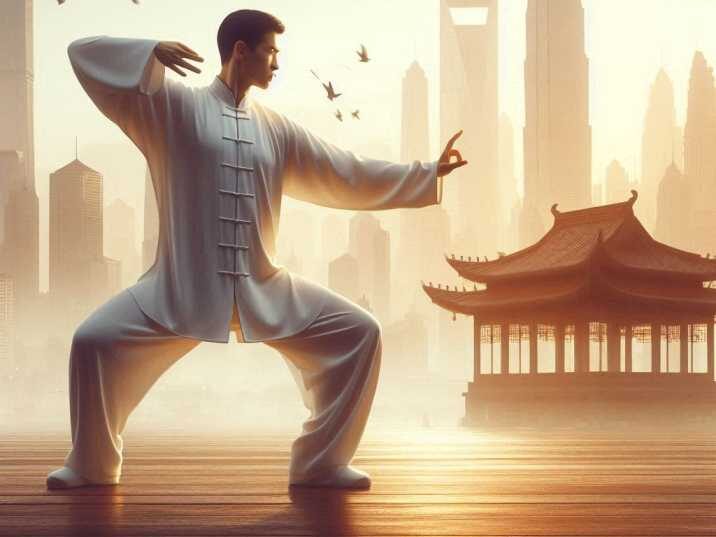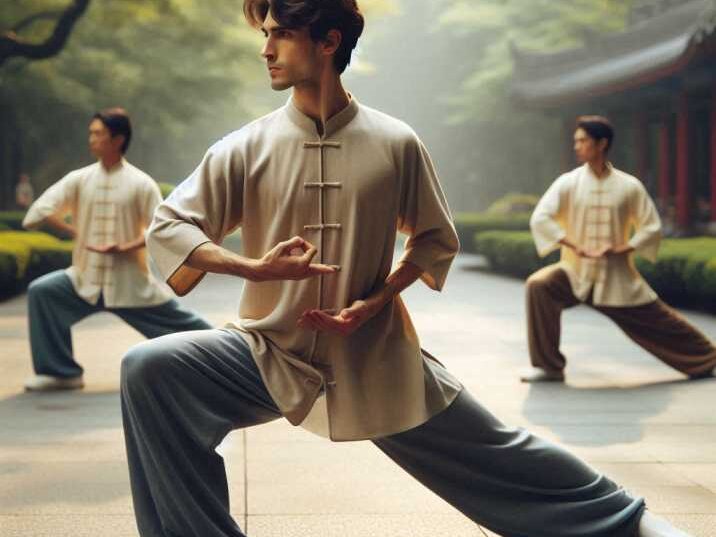Introduction
Table of Contents
Tai Chi, often recognized as a slow and graceful martial art, might not seem like a natural choice for self-defense. However, its principles and techniques offer unique advantages for personal protection. In this article, we will explore how Tai Chi can be effectively used for self-defense, shedding light on its principles, techniques, and the benefits it offers. Whether you’re a curious beginner or someone looking to deepen your understanding of this ancient art, this guide will provide valuable insights into the world of Tai Chi self-defense.

Table of Contents
- What is Tai Chi?
- History and Origins
- Basic Principles
- Tai Chi and Self-Defense
- Core Techniques
- Applying Tai Chi Principles in Real Situations
- Benefits of Tai Chi for Self-Defense
- Physical Benefits
- Mental Benefits
- Tai Chi vs. Other Martial Arts
- Comparison with Traditional Martial Arts
- Why Choose Tai Chi?
- How to Get Started with Tai Chi Self-Defense
- Finding a Class
- Practicing at Home
- Common Misconceptions About Tai Chi and Self-Defense
- Conclusion
- FAQs
What is Tai Chi?
History and Origins
Tai Chi, or Tai Chi Chuan, is an ancient Chinese martial art known for its slow, deliberate movements and deep breathing. It originated in China during the 16th century, with its roots deeply embedded in Taoist philosophy. The art was originally developed for self-defense and has evolved into a practice that improves overall well-being.
Basic Principles
The core principles of Tai Chi include:
Yin and Yang: The Balance of Opposing Forces
Yin and Yang are fundamental concepts in Tai Chi that originate from ancient Chinese philosophy. They represent the idea that all things in the universe consist of complementary yet opposing forces. In Tai Chi, these forces are not seen as conflicts but as interdependent elements that work together to create harmony and balance.
- Yin is often associated with qualities such as softness, stillness, and receptivity. It is the passive force, symbolized by the moon and the feminine aspect. In Tai Chi practice, Yin represents the yielding and absorbing aspect of movement.
- Yang contrasts with Yin, embodying qualities like hardness, activity, and assertiveness. It is the active force, symbolized by the sun and the masculine aspect. Yang in Tai Chi represents the pushing and directing force in movements.
In Tai Chi, achieving balance between Yin and Yang involves blending softness with strength and stillness with movement. For instance, when performing a Tai Chi form, a practitioner may use a soft, flowing motion to redirect an opponent’s force, demonstrating the Yin quality, while simultaneously applying a firm and decisive action, demonstrating Yang.
Chi (Qi): The Vital Life Force or Energy
Chi (or Qi) is the concept of vital life force or energy that flows through the body. It is a key principle in Tai Chi and many other Chinese martial arts and healing practices. Chi is believed to be the fundamental energy that sustains life and influences physical health and mental well-being.
- Flow of Chi: In Tai Chi, the smooth and continuous flow of Chi through the body is essential. Practicing Tai Chi helps to cultivate and balance this energy, which can enhance overall vitality and health. Movements are designed to be slow and deliberate to ensure that Chi flows smoothly without obstruction.
- Cultivating Chi: Tai Chi exercises, including breathing techniques and specific movements, are used to strengthen and harness Chi. By practicing Tai Chi, practitioners aim to increase their awareness of Chi, improve its circulation, and maintain its balance.
- Connection with Chi: Tai Chi teaches that a balanced flow of Chi leads to improved health, mental clarity, and emotional stability. Practitioners often report feeling more centered and energized as they align their physical movements with the flow of Chi.
Relaxation and Centering: Maintaining a Calm and Centered Mind While Moving
Relaxation and Centering are critical aspects of Tai Chi practice. These principles emphasize the importance of maintaining a calm and focused mind while performing movements.
- Relaxation: Tai Chi movements should be performed in a relaxed and fluid manner. Tension and stiffness are counterproductive, as they disrupt the natural flow of Chi and hinder the effectiveness of the movements. Practicing relaxation helps to reduce stress, enhance flexibility, and improve overall body awareness.
- Centering: Centering involves focusing on your body’s core and maintaining a sense of balance and stability. In Tai Chi, this means grounding yourself through your feet, aligning your posture, and maintaining a centered position. Centering helps in achieving a stable and controlled movement, which is crucial for effective self-defense and overall well-being.
- Mental Calmness: Along with physical relaxation, Tai Chi encourages mental calmness and clarity. By focusing on the present moment and the flow of movements, practitioners cultivate a peaceful state of mind. This mental calmness enhances decision-making skills and reaction time, which are beneficial in self-defense situations.
Tai Chi and Self-Defense
Core Techniques
- Push Hands (Tui Shou): Push Hands is a partner exercise in Tai Chi designed to develop sensitivity and responsiveness to an opponent’s movements. Practitioners learn to feel and adapt to their partner’s force, improving their ability to neutralize and counter attacks effectively.
- Form Movements: Tai Chi forms are sequences of movements that emphasize balance, coordination, and fluidity. These forms can be adapted for self-defense by using their principles to create defensive and offensive techniques, such as evading or redirecting an attacker’s force.
- Redirecting Force: In Tai Chi self-defense, the principle of redirecting force involves using an opponent’s energy and momentum against them. Instead of meeting force with force, practitioners guide and redirect the attacker’s movements, leveraging their own energy to neutralize the threat efficiently.
Applying Tai Chi Principles in Real Situations
In real self-defense scenarios, Tai Chi principles can be applied as follows:
- Softness Over Hardness: Instead of meeting force head-on, Tai Chi teaches you to yield and redirect.
- Balance and Stability: Maintaining a strong base and balance helps in controlling an opponent’s movements.
- Calmness and Focus: Staying calm allows for better decision-making and reaction time.
Benefits of Tai Chi for Self-Defense
Physical Benefits
- Improved Flexibility and Strength: Regular practice enhances muscle tone and joint mobility.
- Better Balance and Coordination: Essential for effective self-defense.
- Enhanced Reflexes: Tai Chi trains your body to respond quickly to threats.
Mental Benefits
- Stress Reduction: Tai Chi’s meditative movements help in reducing anxiety.
- Increased Awareness: Enhances your ability to perceive and react to potential dangers.
- Mental Clarity: A focused mind is crucial in self-defense situations.
Tai Chi vs. Other Martial Arts
Comparison with Traditional Martial Arts
Unlike many traditional martial arts that focus on striking and grappling, Tai Chi emphasizes internal strength, balance, and fluid movement. While it may not have the same immediate impact as some striking arts, its principles of redirection and balance can be highly effective in self-defense situations.
Why Choose Tai Chi?
Tai Chi offers a gentle approach that is suitable for people of all ages and physical conditions. It provides a unique combination of physical and mental training that can be beneficial in self-defense without the need for aggressive techniques.
How to Get Started with Tai Chi Self-Defense
Finding a Class
Look for local Tai Chi classes or instructors who specialize in self-defense applications. Many community centers and martial arts schools offer Tai Chi courses.
Practicing at Home
If you prefer practicing at home, there are numerous online resources and instructional videos available. Start with basic forms and techniques and gradually incorporate self-defense applications.

Common Misconceptions About Tai Chi and Self-Defense
- Tai Chi is Too Slow for Self-Defense: Tai Chi movements may be slow, but they are designed to be effective and precise.
- Tai Chi is Only for Relaxation: While Tai Chi promotes relaxation, it also includes powerful self-defense techniques.
- You Need to Be a Master to Use Tai Chi for Self-Defense: Basic principles and techniques can be applied effectively even by beginners.
Conclusion
Tai Chi is more than just a form of gentle exercise; it is a comprehensive martial art with practical self-defense applications. Its principles of balance, relaxation, and redirection offer valuable skills for personal protection. Whether you’re looking to enhance your self-defense abilities or simply enjoy a new form of exercise, Tai Chi provides a unique and effective approach.
FAQs
1. Can Tai Chi be used for real self-defense?
Yes, Tai Chi’s principles of balance, redirection, and sensitivity make it effective for self-defense.
2. How long does it take to learn Tai Chi for self-defense?
It varies, but consistent practice over several months can provide a solid foundation in Tai Chi self-defense techniques.
3. Is Tai Chi suitable for all ages?
Yes, Tai Chi is adaptable and can be practiced by people of all ages and fitness levels.
4. Do I need any special equipment for Tai Chi?
No special equipment is needed. Comfortable clothing and a clear space to practice are sufficient.
5. Can Tai Chi be combined with other martial arts for self-defense?
Yes, Tai Chi can complement other martial arts by adding balance and internal strength to your skill set.


